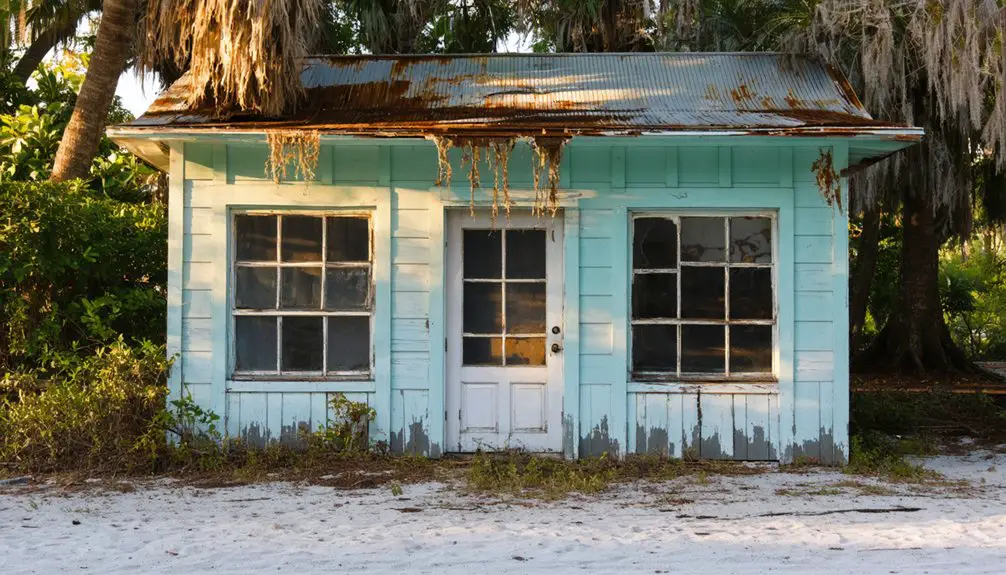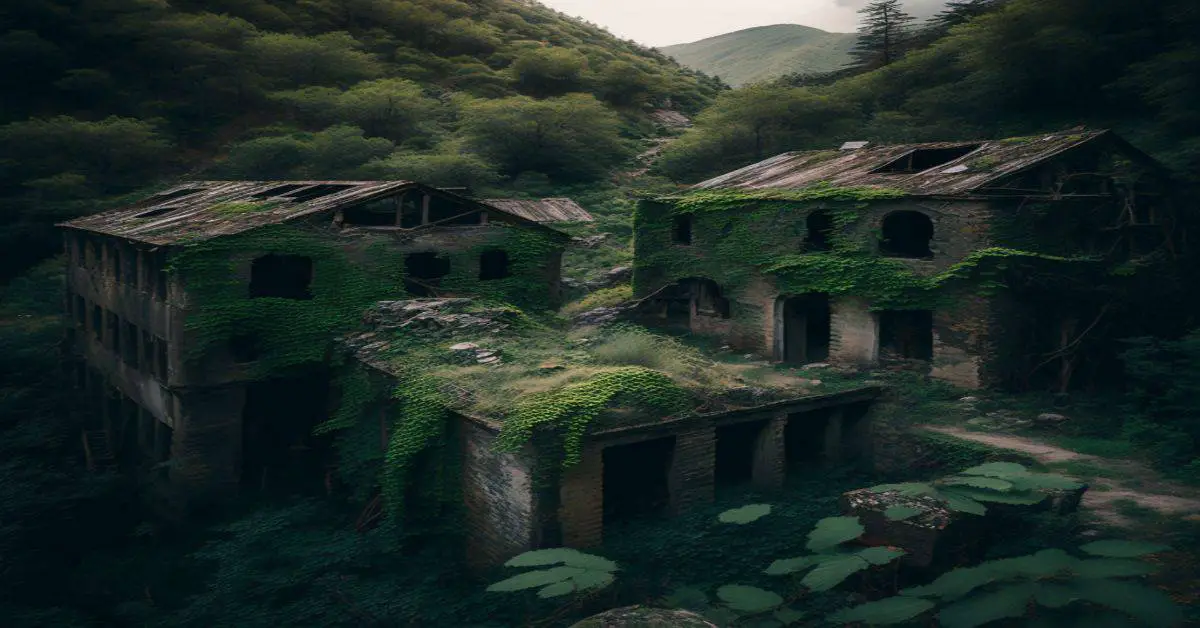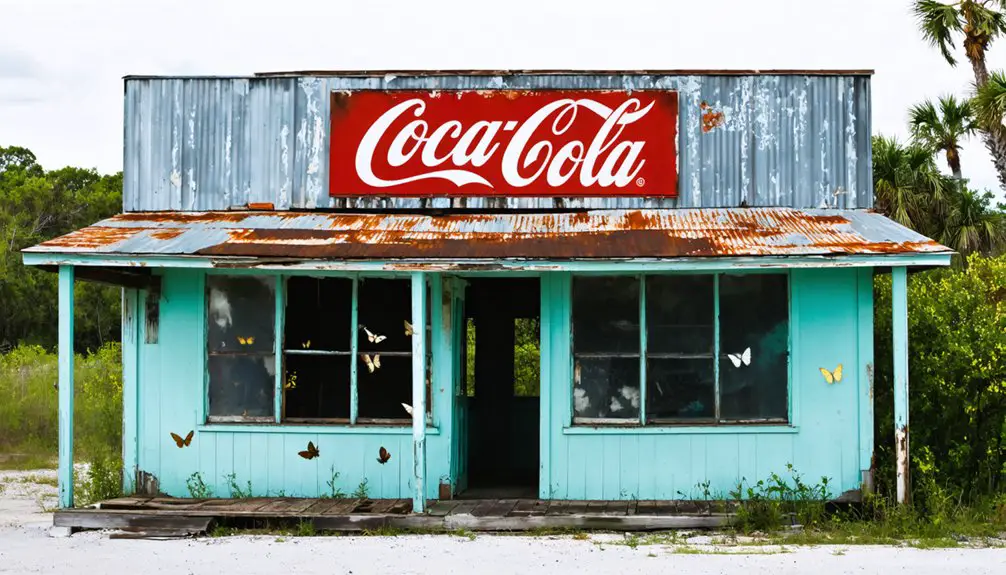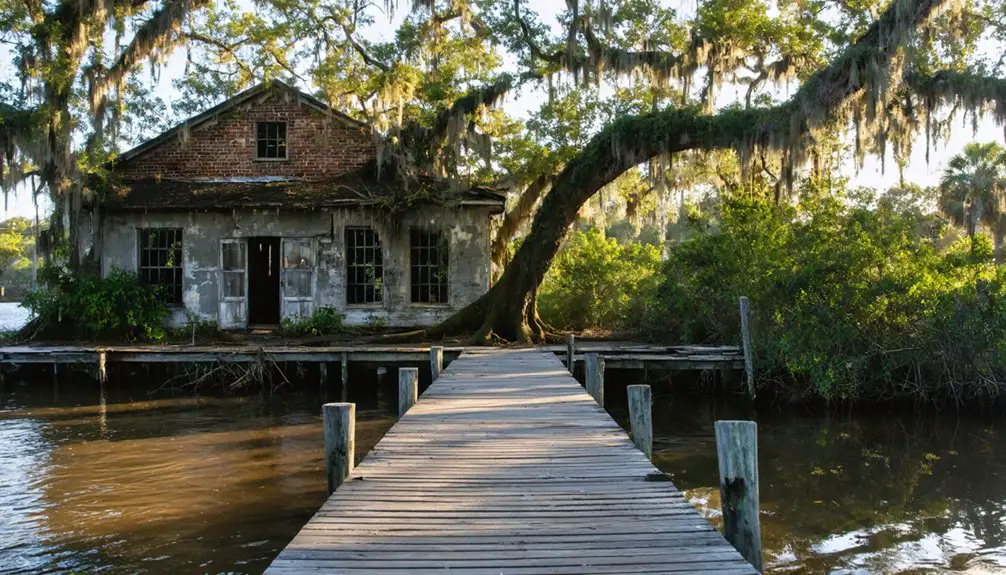You’ll discover Florida’s ghost towns scattered across the state, from Fort Dade’s abandoned military batteries to forgotten resort communities like Suwannee Springs. These lost settlements flourished during the late 1800s and early 1900s, offering glimpses into Florida’s past through deteriorating railways, brick highways, and coastal ruins. Natural disasters, economic shifts, and changing technologies led to their decline, but their remnants serve as outdoor museums where Florida’s complex history awaits exploration.
Key Takeaways
- Fort Dade, once home to 300 residents, now stands abandoned with deteriorating military structures and a single park ranger.
- Former resort towns like White Sulfur Springs and Suwannee Springs declined despite their popularity as Florida’s earliest tourist destinations.
- Economic shifts, natural disasters, and abandoned railroads led to the disappearance of towns along Old Dixie Highway.
- Espanola and Bennell exemplify communities that thrived during Florida’s early transportation boom but later vanished.
- Historic railway hubs, including Richloam’s depot, reveal the rise and fall of Florida’s logging and transportation industries.
The Military Legacy of Fort Dade
As Spanish-American War tensions mounted in 1898, the U.S. military established Fort Dade on Egmont Key to protect Tampa Bay from potential naval attacks.
You’ll find a rich artillery history here, where five gun batteries once stood ready to defend Florida’s western coast.
At its peak around 1920, this coastal defense installation wasn’t just a military outpost – it was a thriving community of over 300 residents complete with modern amenities like electricity, telephones, and brick roads.
Fort Dade flourished beyond its military role, becoming a modern town where hundreds lived with cutting-edge conveniences of the era.
You’d have found everything from a movie theater to bowling alleys, making it a self-contained military town. The fort’s development included construction of twelve initial buildings in 1899, setting the foundation for its rapid growth.
While the Spanish fleet never attacked, Fort Dade served actively during World War I, hosting mine operations and aerial gunnery exercises before technology rendered coastal forts obsolete, leading to its deactivation in 1923. Following the Second Seminole War, many military installations like Fort Dade became crucial in establishing a stronger U.S. presence throughout Florida.
Lost Towns Along Florida’s Highways
While Florida’s modern highways buzz with traffic, they hold secrets of forgotten towns that once thrived along their predecessors.
You’ll find traces of these lost communities along Old Dixie Highway, where places like Espanola and Bennell once bustled with hotels, shops, and post offices. These towns fell victim to economic shifts, abandoned railroads, and natural disasters that reshaped Florida’s landscape.
You can still discover brick-paved remnants of the original highway, sourced from Alabama, Georgia, and Tennessee manufacturers. Tourism grew rapidly as shown by car traffic increasing from 453 vehicles in September 1915 to 647 by October 1915. The historic route was a crucial path for travelers heading to Florida, stretching from Miami to Michigan.
The devastating “Big Freeze” of 1894-1895 wiped out entire communities in Marion, Lake, and Sumter counties, while hurricanes claimed others.
When transportation routes modernized and industries failed, residents relocated, leaving behind only foundations and historic markers as evidence of their existence.
Natural Springs and Forgotten Resorts
Florida’s natural springs once drew visitors from across the nation to luxurious health resorts that now exist only in memories and ruins.
You’ll find the remnants of these forgotten springs scattered across the state, including Suwannee Springs Resort, which offered healing waters to 150 guests at a time in its heyday.
At White Sulfur Springs, Florida’s first tourist destination, you could have stayed in one of 14 luxury hotels while seeking cures for ailments in the mineral-rich waters.
Guests flocked to White Sulfur Springs’ luxury hotels, seeking healing in Florida’s pioneering mineral waters resort destination.
These resorts thrived despite setbacks like the Second Seminole War and economic pressures, offering amenities from bowling alleys to bath houses.
Today, places like Suwanacoochee Spring quietly discharge millions of gallons daily, their peaceful settings a stark contrast to the bustling health tourism destinations they once were.
A weekly stagecoach from Tallahassee to Jacksonville provided the only access for early tourists seeking the springs’ therapeutic benefits.
Suwannee Springs faced multiple tragedies when its three hotels burned in separate fires between 1884 and 1925.
Coastal Communities Time Forgot
Along Florida’s weathered coastline, you’ll discover haunting reminders of communities that once thrived but now stand frozen in time. From Fort Dade’s crumbling military ghost town on Egmont Key to the cursed ruins of Bulow Plantation, these abandoned settlements tell tales of natural disasters, economic downturns, and cultural conflicts that reshaped Florida’s shoreline.
You’ll find coastal ruins ranging from classic ghost towns to declining communities barely holding on. At Fort Dade, brick roads lead to deteriorating batteries where over 600 residents once lived among tennis courts and movie theaters. Only one park ranger remains as a permanent resident, maintaining a solitary watch over the island’s historic grounds. An 1830 census revealed the plantation housed 193 enslaved workers who maintained the sprawling sugar mill operations.
The haunted Bulow Plantation offers a darker history, where Seminole conflicts left sugar mills in ruins and sparked centuries of paranormal folklore. These sites now serve as outdoor museums, preserving Florida’s complex coastal heritage for adventurous explorers seeking connection to the past.
Historical Transport Hubs That Vanished
Throughout the late 1800s and early 1900s, a complex network of railways transformed Florida’s wilderness into bustling transport corridors that you can still trace today.
As you explore these transportation decline sites, you’ll discover the remnants of an era when rail lines were lifelines for emerging communities. Henry Flagler’s visionary Florida East Coast Railway paved the way for coastal development from Jacksonville to Key West.
The Lee Cypress Railroad operated near Copeland as a vital logging operation that transported timber for over four decades until after World War II.
- Richloam’s depot stands as a monument to the logging industry’s rise and fall, now surrounded by recovering cypress swamps.
- The St. Johns & Lake Eustis Railway’s legacy lives on through Tavares Depot and the Orange Blossom Cannonball experience.
- Railway remnants of the Harrisburg to Everglades City line reveal pioneer attempts to tame Florida’s wild southwestern frontier.
- Along the Nature Coast State Trail, you’ll find historic stations and the 1902 steel trestle where transport history converged at Wilcox Junction.
Frequently Asked Questions
Are Any of Florida’s Ghost Towns Legally Accessible for Public Exploration?
You’ll find legal public access to several ghost towns through state parks and Biscayne National Park, while others have strict legal restrictions requiring landowner permission or guided tours.
What Role Did Hurricanes and Natural Disasters Play in These Towns’ Abandonment?
You’ll find that hurricanes and natural disasters played a devastating role, repeatedly demolishing communities like Stiltsville. Storm damage, severe flooding, and extreme freezes forced residents to abandon their towns permanently.
Do Any Ghost Towns in Florida Have Documented Paranormal Activity?
You’ll find documented haunted locations across Florida’s ghost towns, from Slavia’s transparent boy to St. Augustine’s Old Jail Museum, where urban legends are backed by paranormal investigations and historical records.
Which Florida Ghost Towns Still Have Active Preservation or Restoration Efforts?
You’ll find active preservation projects at Eldora House in Canaveral, Fort Dade on Egmont Key, Floyd’s Mound, and Ethel, where restoration initiatives include cabin rebuilding and archaeological site protection.
How Many People Still Live Near or Within Florida’s Abandoned Town Sites?
While Fort Dade sits empty, you’ll find current population clusters in nearby communities, with hundreds to thousands of residents living within 5-10 miles of most abandoned town sites across Florida.
References
- https://www.florida-backroads-travel.com/florida-ghost-towns.html
- https://www.ghosttowns.com/states/fl/fl.html
- https://www.timeout.com/florida/florida-ghost-towns
- https://www.youtube.com/watch?v=bNjqcQ5SMwg
- https://www.freakyfoottours.com/us/florida/
- https://en.wikipedia.org/wiki/Dade_battle
- https://www.legendsofamerica.com/fort-dade-egmont-key/
- https://digitalcommons.usf.edu/cgi/viewcontent.cgi?article=1303&context=sunlandtribune
- https://www.museumoffloridahistory.com/explore/exhibits/permanent-exhibits/world-war-ii/historical-sites/westcentral-listing/fort-dade/
- https://www.floridastateparks.org/learn/history-egmont-key



